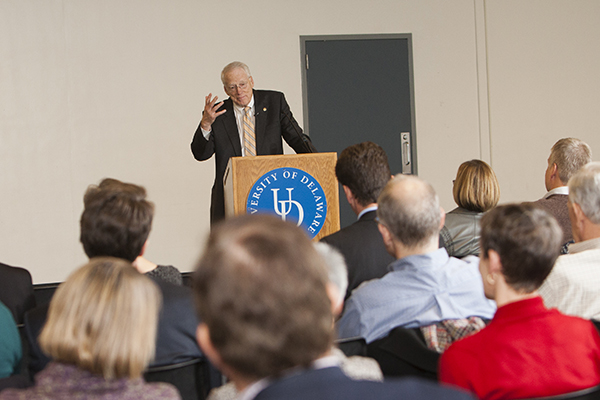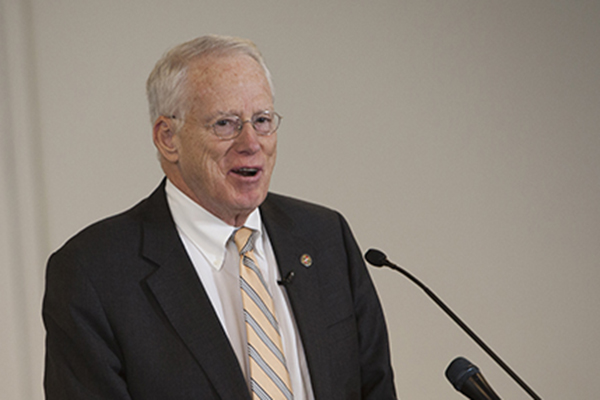

The future of research universities
Maryland chancellor shares ideas to enhance effectiveness of America's research universities
10:20 a.m., Dec. 16, 2013--For research universities to produce the ideas and talent the United States needs in order to lead in the 21st century, they “must make a steady and persistent movement to adapt to the times,” according to William (Brit) Kirwan, chancellor of the University System of Maryland (USM).
Kirwan spoke on the future of research universities on Wednesday, Dec. 11, at the University of Delaware. The talk, presented to a group of UD faculty and administrators, was designed to help set the scene and percolate new ideas as UD considers the next phase of its Path to Prominence strategic plan, a process that will begin in the new year.
Research Stories
Chronic wounds
Prof. Heck's legacy
During his talk, Kirwan focused on three of the 10 recommendations for enhancing the prosperity and effectiveness of research institutions that are outlined in the 2012 National Research Council report Research Universities and the Future of America.
First up: increasing cost-effectiveness and reducing student debtload.
Kirwan pointed out that student debt increased by 10 percent in the last year alone, and that college graduates whose home residence is Delaware currently carry the largest student debt nationally ($33,649).
Yet there are still ways that universities can reduce costs while educating more Americans, from implementing better procurement practices to pursuing cloud computing, Kirwan said. He sees the biggest opportunity for cost-savings in how education is delivered.
“High-quality courses and lower delivery costs may be possible due to the power and adaptability of computing, the ubiquitous nature of the Internet and advances in the cognitive sciences,” he said.
Kirwan described how USM is redesigning classes to focus more on problem-solving, an approach for which UD is nationally recognized. In the Interdisciplinary Science and Engineering Laboratory (ISE Lab) dedicated in October, students engage in “problem-based learning,” in which they discuss problems and possible solutions in classrooms equipped with desks on wheels to facilitate group work, and then can go immediately into an adjacent lab to test ideas.
Instruction that takes advantage of “intelligent software-driven material” also is proving to have a measurable impact on student learning, Kirwan said. USM has created a center for innovation in research and teaching that is evaluating the effectiveness of such approaches, as well as massively open online courses (MOOCs), hybrid and flipped classrooms.
“We’re guided by evidence, not by hope or hype,” Kirwan said.
Regarding the National Research Council report’s recommendation for universities to strengthen partnerships with business, Kirwan called for more of a “peer to peer” relationship versus the “customer and supplier” relationship of today.
Universities are especially valuable to industry now since so many companies have reduced or eliminated their research and development operations, Kirwan said, but they need to streamline ways to work together. Standardized technology transfer policies are needed across academia to foster collaboration and enlarge the innovation pipeline. Promotion and tenure policies that reward researchers for entrepreneurialism in addition to teaching and research are critical to incubating new ideas.
To accelerate “time to innovation,” Kirwan spoke of programs such as InvestMaryland, which he helped to develop with the state of Maryland that invests in young, high-tech companies. Funding comes from auctions on corporate tax credits.
Additionally, professional “site miners” act like technology extension agents for the university, visiting research labs to identify ideas that have commercial potential. Thirty companies already have been developed since eight professionals recently were hired in this role at USM, he said.
Kirwan’s final points focused on the report’s recommendation to provide the full benefits of education to all, including minorities.
“We’re staring at the possible disappearance of the American dream,” Kirwan warned.
Children of less educated parents in the U.S. now have a harder time than those from almost any other industrialized country in getting a college education, Kirwan said. He chastised using institutional financial aid to “buy” students of means who would go to a university anyway, but instead urged a recalibration of financial aid to a need-based versus merit-based system.
“In today’s economy, education provides the only reliable path to a successful career and high-quality of life,” Kirwan said.
Kirwan, who was warmly welcomed to UD by University President Patrick Harker, noted that he has “a great connection to, and a deep admiration for, the University of Delaware.”
Among the projects the two universities are collaborating on is “MADE CLEAR,” a National Science Foundation project to provide research-based instruction and resources on climate change and sustainability to science educators and students.
Article by Tracey Bryant
Photos by Ambre Alexander










